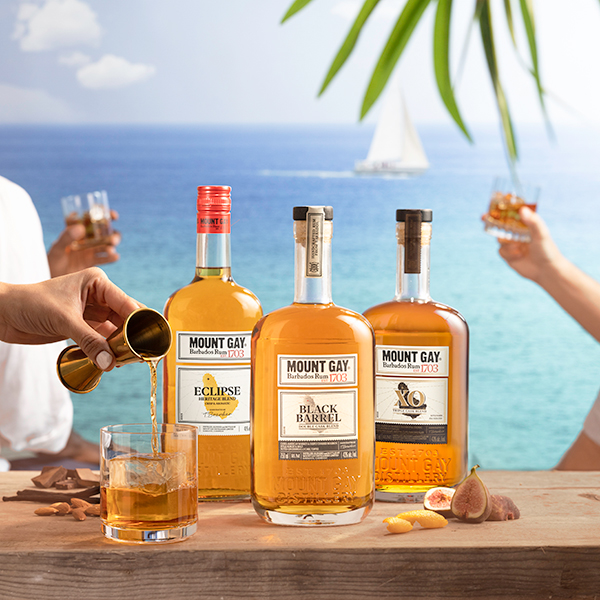
What’s bright and bitter and loved all over? It’s the Aperol Spritz, the super Instagrammable, fizzy aperitif that’s popped up everywhere from music festivals to happy hours nationwide. Everyone’s new favorite drink isn’t exactly new, and its exploding popularity isn’t exactly an accident.
Aperol was created by the Barbieri brothers in Padua, Italy in 1919. Its creators originally marketed it throughout the 1920s and ’30s as a drink “for women and sportive people” to help them stay lean and fit. In the 1950s, the now-classic Aperol Spritz recipe hit the market, quickly becoming one of Italy’s favorite low-alcohol beverages. When Gruppo Campari bought Aperol in 2003, it used its global reach to spread the spritz in an effort to increase distribution.
If that push seems stronger in recent years, you’re not imagining things. Last month, Campari America marketing executive Melanie Batchelor told The New York Times that the company made a concerted effort to draw the American palate to the drink, starting a few years ago. Those efforts included booths at New York City summer events such as the Jazz Age Lawn Party and the Governors Ball, as well as events in the Hamptons, Los Angeles, and Palm Springs.
Just open your Instagram feed and you’ll see why it worked — the drink is as beautiful as it is sippable.
A standard Aperol Spritz is made using a 3-2-1 ratio: three parts Aperol, two parts Prosecco or sparkling wine, and one part soda. But as Clair McLafferty, a bartender and author of “The Classic & Craft Cocktail Recipe Book,” points out, the recipe is as flexible as a summer afternoon.
“The traditional Aperol Spritz is a very forgiving cocktail, in that if you are eyeballing the measurements instead of measuring it out exactly, you’ll still have a tasty drink once you’re done pouring,” McLafferty says. “Home bartenders should feel free to adjust it to their own personal taste. Every human has a different palate, and what is attractive to me may be disgusting to you.”
Aperol Spritz’s easy formula and drinkability also lend it well to variation, whether mixing up a pitcher on the porch or ordering one at your favorite watering hole. As a result, bars nationwide have started pumping out spritzes of their own to capitalize on the trend.
At Dante NYC, creative director Naren Young first declared the “summer of spritz” last year, with a full menu dedicated to Aperol Spritz and variations. It went over so well that the special menu returned this season and will stick around as long as the weather — and demand — hold. Options include an Aperol Spritz on tap and an Aperol popsicle made in partnership with OddFellows Ice Cream Co. Young credits the drink’s popularity to its fun, easy-drinking character.
“It’s very inoffensive, it goes down really easily,” Young says. “It’s not the sort of drink you have to think about too much. It’s just refreshing and delicious.”
Serving the spritz on tap allows Dante to pump them out quickly, to the tune of about 450 a week. The method also means the entire drink gets carbonated, so it comes out slightly fizzier than the traditional. Young said the spritz-focused menu, which features savory, spicy, and floral takes on the theme, provides “a little something for everybody,” so visitors can go on a spritz journey without leaving their barstools.
Juniper in Austin, Tex., also offers a tour de spritz on its aperitivo menu. The classic Aperol Spritz uses Topo Chico for Mexican flare and a nod to the mineral water’s rabid popularity. Visitors who want the fresh, fizzy character of a spritz without Aperol’s signature bitter bite can also try the Garibaldi’s Guard. That version uses Galliano instead for a more mellow take on the theme.
Coppa Boston serves its house Aperol Spritz on draft, with a twist. Bartenders use Alessio Bianco, a variation on traditional sweet vermouth with an herbal, orange-forward flavor. It is offered by the glass or pitcher to capitalize on the drink’s social, shareable nature.
A Sbagliato cocktail also appears on Coppa’s menu. Legend has it, the Sbagliato came about when a bartender accidentally used sparkling wine instead of gin when making a Negroni, resulting in the happy “mistake.” The Sbagliato, which uses Campari, Prosecco, and vermouth, makes a great transition for Negroni fans looking to get into spritz territory.
At Rose Café in Venice, Calif., the F.A.D.E.D. cocktail gives the spritz a Southwestern twist on the concept. Made with blanco tequila, Aperol, rosé wine, citrus, and strawberry, the F.A.D.E.D. resembles an Aperol Spritz crossed with a fruit-forward Margarita. The fruit and tequila in this version provide a tasty compromise for those who tend to shy away from the bitterness of many Italian amaro. (Purists, take heart: A classic Aperol Spritz is still on the brunch cocktail menu.)
Rachel Knox of The Hop Shop in Brooklyn likes to keep her spritzes light, even when mixing up variations. “I’ve seen a lot of people making them with heavier booze, and I think that just defeats the purpose,” she explained. “[Aperol Spritzes] are refreshing without being too much of any one flavor — a good spritz should be a balance of bitter, sweet, and bubbly.”
Lately, Knox has enjoyed making her spritzes with Aperitivo Cappelletti, an amaro similar to Campari, plus rosé wine and LaCroix Pamplemousse. The light, fruity version marries two of everyone’s favorite happy- hour orders.
For those who want to get creative with the spritz trend at home, Leigh Kunkel recommends an Aperol-infused Blood Orange Collins. The Chicago-based writer and recipe developer, formerly of Maple and Ash and El Che Bar, likes spritzes for hanging out on the deck because they’re low-alcohol and easy-drinking. But if you bought a bottle and didn’t quite get to the bottom, or want a long drink with a little more oomph, the Blood Orange Collins will take you from poolside to post-sunset.
Maybe you have a few bottles of leftover sweet sparkling wine languishing in your fridge, post-party. Cocktail writer and recipe developer Emily Farris sees that as an opportunity.
“I’m fine getting a little loose with the recipe to finish off any sweet sparkling wines that end up in my fridge after a party,” Farris says. She mixes up the wine and the Aperol to taste and tops it off with whatever fizzy water she finds lying around. “It’s not going to win any bartending awards, but it goes down just fine,” Farris says.
Whether at home or at the bar, the Aperol Spritz offers an easy, almost foolproof inroad into the wonderful world of Italian aperitivo. While its creators may have originally intended Aperol as a sporty woman’s drink of choice, its popularity shows the #summerofspritz works for everyone.
Blood Orange Aperol Collins
Leigh Kunkel
Ingredients
2 ounces gin
¾ ounce lemon juice
¾ ounces Aperol
½ ounce Salerno blood orange liqueur
Club soda
Blood orange wheel for garnish
Directions
- Combine gin, lemon juice, Salerno, and Aperol in a shaker with ice.
- Shake and strain into a Collins glass over fresh ice.
- Top with club soda and garnish with a blood orange wheel.
Rose Spritz
Rachel Knox of The Hop Shop
Ingredients
2 ounces Cappelletti Rosso
2 ounces rosé wine
Pamplemousse LaCroix
Directions
- In a wine glass, combine the rosé and Cappelletti.
- Add ice and top with LaCroix to fill.
- Garnish with a lemon peel.

